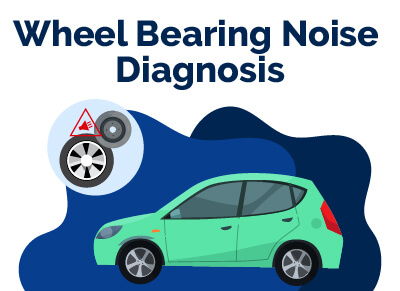Wheel Bearing Noise Diagnostics: A Useful Guide
August 9, 2023


Chris is Head of Content for FindTheBestCarPrice and is based out of Philadelphia, PA. As a seasoned automotive industry analyst and car enthusiast, he ensures the highest level of quality across all our content and curates our picks for the best deals each month.
Chris studied information systems and marketing at Drexel University and writes about a wide range of topics ranging from car buying tips to troubleshooting common mechanical issues.
When he’s not thinking about cars, he likes to stay in with his dog and make an “attempt” to finish a crossword puzzle (he’s not quite at the Saturday/Sunday level…yet). As a former cheesemonger, Chris still has a “sharp” passion for all things cheese, and his fridge is always loaded with it!
Chris also has a passion for things that go fast, and drones are no exception. He spends some of his time writing for Dronesourced.
Identifying wheel bearing noise can present a formidable challenge, as it can easily be misattributed to tire noise. Even when a malfunctioning wheel bearing is the culprit, pinpointing the affected wheel can prove arduous.
The primary function of a wheel bearing is to facilitate smooth wheel rotation with minimal friction. When a vehicle comes to a stop, the bearings undergo a cooling process, resulting in the generation of a vacuum caused by the interplay between lubricant, air, and contacting metal.
A hallmark sign of a faulty wheel bearing typically manifests as cyclic chirping, squealing, or growling noises that vary in intensity concerning vehicle speed.
The sound may abate at certain speeds or only manifest within specific speed ranges. Furthermore, the noise may exacerbate during turns or intermittently disappear altogether.
As such, solely relying on auditory cues for diagnosis can be a formidable task. Let’s look at all wheel bearing noise diagnostics aspects and much more.
Table of Contents
What Is Wheel Bearing?
A wheel bearing comprises a collection of hardened steel balls ensconced within a metallic race or ring.
Situated at the heart of the wheel and nestled within a hollow metal hub, the wheel bearings snugly occupy this space and rest upon a robust axle shaft to minimize friction as the wheel rotates.
Unlike engine bearings that receive continuous lubrication, wheel bearings lack such provisions, necessitating a tight seal to ward off water and road debris.
Furthermore, they endure the immense burden of supporting the entire weight of the vehicle while in motion, enduring the brunt of harsh conditions such as uneven roads, potholes, and lateral forces when negotiating turns.
As with other automotive components, wheel bearings are not immune to the effects of wear and tear and may eventually succumb to degradation, necessitating replacement.
Wheel Bearing Noise Diagnostics
The noise in question can be deceptive, as other issues, such as a sticking caliper or a loose brake pad, can also produce a metallic scraping noise when they rub against the brake rotor.
The frequency of this noise may also change relative to vehicle speed but often subsides or alters when the brakes are lightly applied.
Noise that solely occurs during braking typically indicates a brake problem, such as worn brake pads, rather than a faulty wheel bearing.
Tire-related factors, such as shifted bands or road force imbalance, can also contribute to cyclical noise. Alignment issues leading to uneven tire wear can also be a culprit.
Additionally, worn or failed bushings can transfer cyclical noise to the vehicle's body and frame.
Wheel bearing noises are known to travel through the drivetrain and exit through a transmission or engine mount, resulting in the noise being "grounded" to the chassis far from its source.
This can make early detection of wheel bearing failure challenging for various reasons.
If the growling noise is more pronounced within a specific gear range, it may suggest a worn bearing in the transmission.
Suppose the bearing noise persists regardless of acceleration or deceleration and is approximately three times the wheel speed in frequency. The faulty bearing may be in the transmission output shaft or the driveshaft intermediate support bearing.
A popping or clicking noise while turning is a classic symptom of a deteriorating outer CV joint.
It's also important to assess the condition of the CV joint boot; if torn or leaking, it should be replaced regardless of the joint's condition. Noisy CV joints should also be replaced.
Some worn wheel bearings can be detected by gently rocking the vehicle from side to side at low speeds while gripping the steering wheel.
This method increases the load on the bearings, making any pitted bearing noisier than usual. This test is more effective when the vehicle is warmed up and in a parking area or roadway with light traffic.
A helpful tool for diagnosing wheel bearings is a wired or wireless microphone/stethoscope that can be attached to a knuckle.
While there are no standardized specifications for noise or mounting points for the listening device, it can aid in comparing the bearings on each side during a test drive.
These devices can also assist in ruling out other components that may be the source of cyclical noises, such as CV joints, brakes, and differentials.
When checking for wheel bearing play, the vehicle should be raised so that the wheel is off the ground, and the tire should be grasped at the 12 and 6 o'clock positions and moved back and forth.
There should be no play or looseness if the vehicle has sealed wheel-bearing cartridges or hubs with sealed wheel-bearing assemblies.
Some play is acceptable for older vehicles with serviceable wheel bearings, but excessive play is not. The vehicle's service specifications should refer to the maximum allowable play.
A dial indicator can measure wheel bearing play by placing it against the hub and manually rocking the wheel in and out.
Typically, 0.005 inches of play should be observed if the bearings are in good condition, although some specifications may be so low that play cannot be felt or measured with a dial indicator.
Improper installation of the axle nut is a common cause of wheel bearing comebacks. Most axle nuts should not be reused, as using an old nut may cause it to work loose and compromise the bearing preload.
Loss of preload can result in a low-frequency grumble from the bearing. Retightening the axle nut may temporarily alleviate the noise, but irreversible bearing damage may have occurred in some cases.
Symptoms of a Bad Wheel Bearing
The following are signs that your wheel bearing has gone bad:
1. Vibrations
A deteriorating wheel bearing can result in heightened wheel friction, leading to undesired positional shifts. Consequently, you may encounter unsettling vibrations and tremors while operating your vehicle.
The instability may persist and intensify until the underlying issue with the wheel bearing is effectively addressed and remedied.
2. A Shaky Steering Wheel
A degraded wheel bearing can manifest as an unsteady steering wheel, particularly at lower speeds.
The vibrations may become more pronounced and persistent, extending to occurrences during acceleration, if the issue with the wheel bearing is left unattended.
3. Shaky Wheels
This is a discernible symptom that a skilled mechanic can identify. During a vehicle inspection on a lift, the mechanic can manipulate the wheel to induce lateral movement.
If the wheel assembly exhibits an unsteady or wobbling motion, it likely indicates a wheel bearing issue.
4. Uneven Tire Wear
A malfunctioning bearing can harm your vehicle's alignment, leading to irregular tire wear patterns. When all four tires are properly aligned, making complete contact with the road surface, uneven wear is mitigated.
However, in cases where a wheel bearing is faulty, the most worn tire is often associated with the same wheel where the bearing issue exists.
Causes of Wheel Bearing Noise
The following are the common causes of wheel bearing noise:
1. Driving Through Deep Water Frequently
Engineers ingeniously design wheel bearing seals to allow for pressure relief in the wheel bearings. During the manufacturing process, these seals are installed with a petroleum-based lubricant.
However, this lubricant's inability to prevent water intrusion is a drawback. Therefore, if you drive your vehicle through a flooded street, the wheel bearings would be exposed to moisture.
This moisture would then mix with the lubricant, rendering it ineffective and leading to increased friction and eventual damage to the bearings.
Furthermore, modern wheel bearings are not serviceable or repairable, making replacement the only viable solution for addressing water damage to the bearings.
2. When You Drive on Rough and Untarred Roads
Wheel bearings bear the entire weight of the vehicle as such. This makes them highly susceptible to damage when encountering rough road conditions such as bumpy curbs or potholes.
The impact from such events can force the bearing balls into the grooved ring, known as the race, where the bearing rests, resulting in small imperfections in the bearings.
Continued vehicle operation with these imperfect bearings will generate increased heat and friction, leading to the gradual deterioration of the lubricant in the wheel bearing.
This, in turn, causes tiny particles to break off and contaminate the lubricant, hastening the failure of the wheel bearing.
It is worth noting that the wheel bearing failure may not be immediately noticeable and could take several months before exhibiting noticeable symptoms.
3. Wrong Installation
If your wheel bearings were replaced relatively recently, they would be highly unusual to fail soon after.
The only plausible inference is that the wheel bearings were subjected to damage, likely due to improper installation or deviation from the manufacturer's recommended guidelines.
Best Car Deals by Category
Frequently Asked Questions
How can I diagnose wheel bearing noise?
You can diagnose wheel bearing noise by listening for abnormal noises or conducting a "push-pull" test.
Can wheel bearing noise be mistaken for other issues?
Yes, wheel bearing noise can sometimes be mistaken for other issues, like tire noise or brake issues.
Posted in Car Buying Tips, Car Troubleshooting |




